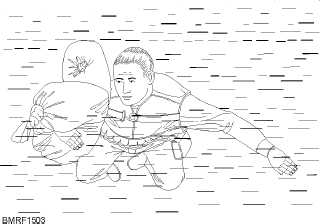5. Swim as far underwater as possible.
6. When you must come up for air, extend your
arms above your head, then pull them back in a
wide sweep to force the upper part of your body
above the surface.
7. When you surface, use your hands and arms to
make wide sweeping movements across the
surface to splash the water and drive away the
flames.
NOTE
As you pop up above the surface, try to
turnyour back to the wind before you
take a breath.
8. Submerge again feet first, and repeat the
procedure until you’re clear of the burning oil.
When going into oil that isn’t burning, save your
preserver to use as a raft. Keep your face above the
surface. Keeping your head above the surface helps
keep oil from getting into your eyes and mouth.
AIDS FOR STAYING AFLOAT.—If you’re in
the water without a life jacket, don’t become frightened
that you can’t stay afloat—you can. Several articles of
clothing, including the white hat, provide some
flotation when used properly. The most useful article is
your trousers or slacks, which you can inflate to serve as
water wings.
1. To remove your trousers, lean forward in the
water and slowly slip them down over your hips
and legs. Don’t let go of them—they may sink.
To inflate your trousers—
2. Zip them; then float them on the surface with the
fly or front turned down.
3. Tie a knot in each leg as close to the cuff as
possible.
4. Work the garment around on the surface until
the legs are over your shoulders and the knots
are behind you, leaving the crotch in front of
you.
5. Grasp the waist of the trousers with one hand on
each side; then extend your arms straight
upward, kicking your feet to get your body as
high out of the water as you can.
6. When this position is reached, pull the trousers
downward smartly on the surface, trapping a
pocket of air in each leg.
7. Then gather the waist under the water and hold
in one hand (fig. 15-3). Keep the trousers legs
wet by splashing water on them to reduce the
loss of the trapped air.
You may use mattress covers, sea bags, laundry
bags, and pillowcases in a similar manner. A large
amount of debris, such as pieces of wood, empty shell
boxes, powder cans, and so forth, is usually present. You
can use this debris to stay afloat.
SURVIVAL EQUIPMENT
The two basic categories of flotation devices are life
preservers and lifeboats. Each is vital to the survival of a
ship’s crew if the ship sinks. Other than the lifeboat, the
life preserver (commonly called a life jacket) is the most
important piece of abandon ship equipment.
The inherently buoyant (vest-type) preserver is
designed so that, if adjusted properly, it supports you
and keeps your head out of the water even if you are
unconscious. With a life preserver on, you can stay
afloat for many days. Without a life preserver, you have
little chance of surviving in the water for any great
length of time.
The lifeboat presents the greatest chance of survival
because it contains food and water, provides shelter
from the elements, and contains equipment that greatly
15-4
Student Notes:
Figure 15-3.—Using inflated trousers/slacks for support.

